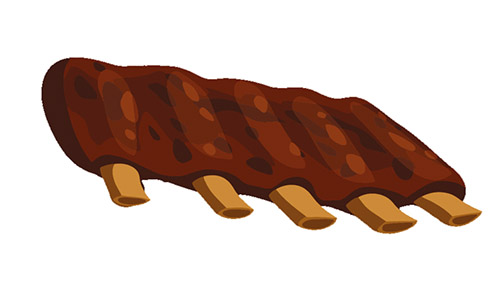
In Missouri, where I grew up initially in a kosher home, then in a kosher-style home, I never ate ribs.
Barbecued ribs are an early 20th century innovation created by the rise of industrial meatpacking, mechanical refrigeration and commercial barbecue stands. Barbecue originated not as a way of “making do” with lesser cuts, but rather as a method of whole-animal cookery—one usually staged for a large crowd. Whole carcasses of pigs, goats, lambs and even cows were cooked over a bed of coals in pits dug in the ground. When people in the 19th century ate barbecued ribs, they pulled the meat from a whole animal that was already cooked. During the mid- to late-1800s, waves of Germans and Czechs, including many Jews, immigrated to the United States, many of whom made their way to the new state of Texas. They started exchanging ideas for how to smoke brisket. Since brisket was still one of the cheapest beef cuts available in Texas at the time, the largest beef-producing state in the country, there was a lot of brisket available. Since the hind quarter of beef isn’t kosher unless the sciatic nerve is removed, that left the forequarter including the brisket. Evidently, it was also popular enough for the smoked version to make it into Jewish grocery stores in Texas—long before it became the darling of our barbecue joints.
The barbecue editor for Texas Monthly found the earliest recorded examples of barbeque brisket in 1910 at two kosher deli butcher shops in El Paso, Texas.
Using brisket, they made deli staples like corned beef and pastrami, which have since become synonymous with Jewish cuisine.
Some purists might say barbeque ribs (kosher) are just Bubby’s brisket presented in a new way.
Here is the award-winning, first-place recipe of Daniel Peikes from the 2018 Chicago kosher BBQ competition.
1 rack (5) kosher beef back ribs
Rub
- ½ cup kosher salt
- ½ cup black pepper
- ½ cup dark brown sugar
- ¼ cup granulated garlic
- ¼ cup granulated onion
- ¼ cup smoked paprika
- ¼ cup celery seed
Pomegranate Barbecue Sauce
- 2 cups ketchup
- ½ cup pomegranate molasses
- ½ cup dark brown sugar
- ½ cup honey
- ½ cup apple cider vinegar
- ½ cup spice rub
- ½ cup apple juice
1. Preheat oven to 250 degrees F. Place ribs on a foil-lined baking sheet.
2. Combine salt, pepper, garlic, onion, paprika and celery seeds in a bowl and thoroughly combine. Reserve ½ cup for sauce.
3. Sprinkle ribs with rub on both sides. Bake in preheated oven 3 hours.
4. Place ketchup, pomegranate molasses, brown sugar, honey, vinegar, apple juice and spice rub in pot. Simmer until all solids are dissolved.
5. Lightly brush ribs with sauce and place in oven for 5 minutes to set the sauce.
These come from an old food magazine, fine for kosher ribs.
Kansas City Rib Rub
- ½ cup brown sugar
- ¼ cup sweet paprika
- 1 t. cayenne pepper
- 1 T. chili powder
- 1 T. garlic powder
- 1 1.2 T. black pepper
- 1 T. kosher salt
Kansas City Barbecued Rib Sauce
- 3 ½ pounds kosher beef ribs
- 7/8 cup ketchup
- ¼ cup apricot or peach preserves
- 2 ½ T. orange juice
- 2 ½ T. lemon juice
- 1 T. soy sauce
- 1 ½ t. hot pepper sauce
- 1 ½ t. paprika
- 1 ½ t. chili powder
1. Preheat oven to 425 degrees F. Place ribs on foil-lined baking sheet.
Bake 45 minutes.
- 2. Combine ketchup, preserves, orange juice, lemon juice, soy sauce, hot sauce, paprika and chili powder in a pan and simmer 20 minutes.
- 3. Reduce oven to 350 degrees F., cover ribs, bake one hour. Start brushing ribs with sauce every 10 minutes, three times.
To Grill:
Bake in 425 degree F. oven 45 minutes. turn half of grill on high and half off.
Place ribs on off side, cover and cook 45 minutes, turn, brush with sauce, cook 30 minutes more, brush with sauce. Turn, and cook 30 minutes more.
Sybil Kaplan is a journalist, author, compiler/contributor/editor of nine kosher cookbooks (working on a 10th) and food writer for North American Jewish publications. She lives in Jerusalem where she has led weekly walks of the Jewish food market, Machaneh Yehudah, in English since 2009. She wrote the kosher Jerusalem restaurant features for Janglo.net, the oldest, largest website for English speakers from 2014 to 2020.











